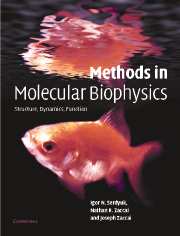Book contents
- Frontmatter
- Contents
- Foreword by D. M. Engelman
- Foreword by Pierre Joliot
- Preface
- Introduction: Molecular biophysics at the beginning of the twenty-first century: from ensemble measurements to single-molecule detection
- Part A Biological macromolecules and physical tools
- Part B Mass spectrometry
- Part C Thermodynamics
- Part D Hydrodynamics
- Part E Optical spectroscopy
- Part F Optical microscopy
- Part G X-ray and neutron diffraction
- Part H Electron diffraction
- Part I Molecular dynamics
- Chapter I1 Energy and time calculations
- Chapter I2 Neutron spectroscopy
- Part J Nuclear magnetic resonance
- References
- Index of eminent scientists
- Subject Index
- References
Chapter I1 - Energy and time calculations
from Part I - Molecular dynamics
Published online by Cambridge University Press: 05 November 2012
- Frontmatter
- Contents
- Foreword by D. M. Engelman
- Foreword by Pierre Joliot
- Preface
- Introduction: Molecular biophysics at the beginning of the twenty-first century: from ensemble measurements to single-molecule detection
- Part A Biological macromolecules and physical tools
- Part B Mass spectrometry
- Part C Thermodynamics
- Part D Hydrodynamics
- Part E Optical spectroscopy
- Part F Optical microscopy
- Part G X-ray and neutron diffraction
- Part H Electron diffraction
- Part I Molecular dynamics
- Chapter I1 Energy and time calculations
- Chapter I2 Neutron spectroscopy
- Part J Nuclear magnetic resonance
- References
- Index of eminent scientists
- Subject Index
- References
Summary
Historical review of biological applications
The first molecular dynamics simulation of a biological macromolecule, the small stable protein bovine pancreatic trypsin inhibitor (BPTI) for which an accurate X-ray crystallographic structure was available, was published by J. A. McCammon, B. R. Gelin and M. Karplus in 1975. Based on a simple approximation for the molecular mechanics potential, the simulation was performed for the macromolecule in vacuum, and limited to 9.2 ps by the computing power available at the time. The BPTI study was nevertheless effectively instrumental, together with the earlier hydrogen exchange experiments of K. Linderstrom-Lang and his collaborators (1955), in establishing the view that proteins are not rigid bodies but dynamic entities whose internal motions must play a role in their biological activity.
In 2003 M. Karplus wrote that molecular dynamics simulations of biological macromolecules developed from two lines of work: individual particle trajectory calculations in chemical reactions and physical calculations to predict the dynamic behaviour of large particle assemblies.
The first line of work goes back to the two-body scattering problem for which analytical solutions are available. It is well known in physics, however, that no analytical solutions have been found for the three (or more)-body problem. A prototype trajectory calculation was attempted in 1936 by J. A. Hirschfelder, H. Eyring and B. Topley for the simple chemical reaction involving the interconversion between hydrogen atoms and molecules, but the calculation could only be completed by using the computers that became available in the 1960s.
- Type
- Chapter
- Information
- Methods in Molecular BiophysicsStructure, Dynamics, Function, pp. 931 - 947Publisher: Cambridge University PressPrint publication year: 2007



